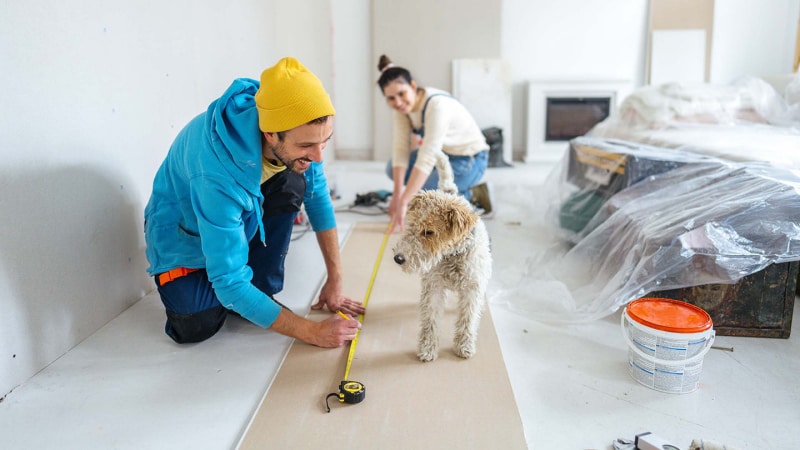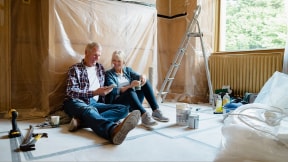Calculating square footage of a house

Quick insights
- Calculating square footage can play an important role in various aspects of real estate such as determining the value of your property or estimating renovation costs.
- First-time homeowners may find it beneficial to calculate the square footage of their home for the following reasons: accuracy in valuation, compliance with zoning laws and efficient use of space.
- When calculating square footage, exclude non-livable spaces, determine if your basement should be included and measure all levels separately.
When it comes to evaluating the space and value of your home, learning how to calculate square footage can be useful for homeowners. From determining property pricing to creating home improvement plans for your next project, the square footage of your home can be an influential component in the real estate world. Square footage is the measurement of an area in square feet, calculated by measuring the length and width of an area in square feet. Whether you are assessing the size of a luxury apartment or cozy countryside home, calculating square footage provides a valid measurement that can impact different elements of real estate such as estimating construction costs or getting a home value estimate. Knowing how to calculate square footage of a house can help homeowners understand their property’s dimensions and potential resale value.
The importance of square footage
Learning about the importance of square footage in various applications can be helpful when evaluating construction, interior designs and other real estate projects. It’s important to properly calculate square footage for many reasons, including:
- Flooring estimates: When renovating, accurately calculating the square footage of a room can help homeowners and contractors determine how much flooring material is needed.
- Home appraisal: Square footage can heavily influence your home’s appraised value. Professional appraisers use the size of your home to compare it to similar homes in the area and determine the property’s market value.
- Building permits: If you are applying for a permit, you may be required to provide the structure's size to your local municipality.
- Home additions: It’s important to be accurate when estimating square footage on any home addition to ensure you don’t purchase too much or too little in terms of building materials.
- Real estate listings: For homeowners looking to sell their home, providing square footage on a real estate listing can help potential buyers determine if your property meets their space needs.
How to calculate square footage
Understanding how to calculate square footage of a house, room, roof and other spaces can provide a great foundation for clear-cut project planning and budgeting. Once you understand how to calculate square footage, it can be a relatively simple task to do. This can help projects move smoothly, keep costs within the budget and ensure regulatory requirements are met.
How to calculate square footage of a house
Calculating the square footage of your home will require more patience because you are measuring the entire house. First, start by measuring and calculating the areas of all living spaces such as bedrooms, living rooms, kitchens and bathrooms. Make sure you calculate the upper levels, basement and detached structures like your garage or shed. It may be helpful to sketch out a floor plan of your house.
How to calculate square footage of a room
To calculate square footage of a rectangular room, multiply its length by its width. Example: 10 x 20 = 200 sq. Feet. To calculate the square footage of an irregular-shaped room, divide the room into smaller sections (squares or rectangles) and measure each section. Then, add up the area of all sections to get the total square footage of the room.
How to calculate roof square footage
To calculate roof square footage and estimate roofing material costs, you need to know what type of roof you have.
- Pitched roof: Measure the length and width of each section, then multiply the measurements to get each section's area. Finally, add the areas of all sections together to get the total roof area.
- Flat roof: Measure the length and width of the entire roof, then multiply those measurements to get the total roof area.
Other tips when calculating square footage
As you begin to calculate the square footage of your home, here are a few additional tips to keep in mind for accuracy and relevancy:
- Exclude unusable spaces: This includes attic spaces and crawl spaces. Unfinished attic spaces that are not suitable for living should be excluded, along with crawl spaces where you can’t stand upright. However, there are usable attics that can be converted into bedrooms or storage facilities. You might need to consider including these spaces, especially if you are counting storage areas and not just living areas.
- Basement considerations: Including the basement in your home’s square footage will depend on several factors including condition and location. In some states, anything below grade/ground is not counted. In terms of condition, a basement must be finished, livable and meet certain criteria to count towards the square footage of your home.
- Measure all levels separately: Measure each level of your home separately, especially if there are major differences in the floor plan.
- Consult with a professional: Speaking with a real estate agent or appraiser can provide valuable guidance to ensure you are following local regulations.
In summary
Whether you are estimating flooring needs or determining property values, precise square footage measurements play a critical role. A few practical tips to take into consideration include measuring wall-to-wall, excluding non-livable spaces and consulting with a professional to get accurate square footage calculations. By following these guidelines, homeowners can make informed decisions and confidently navigate the intricacies of square footage assessment.



